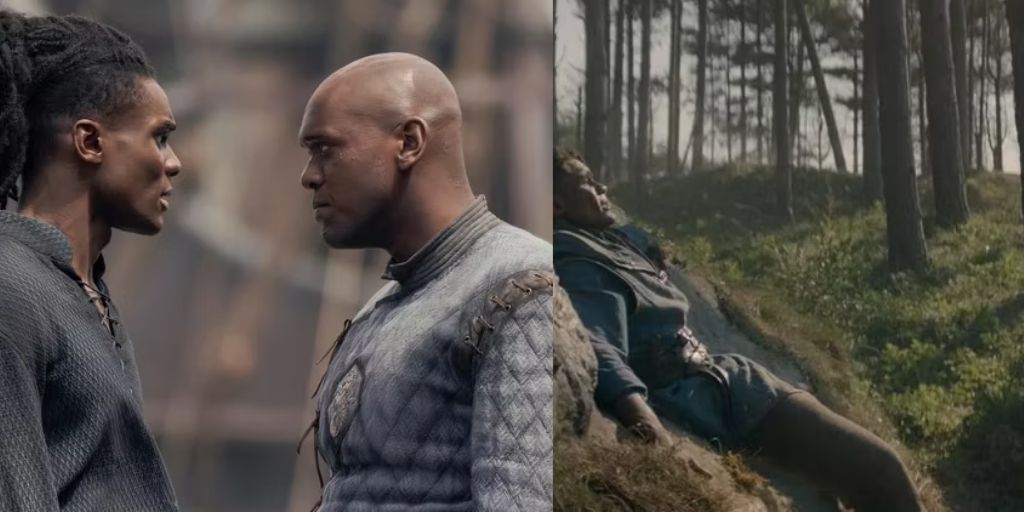House Velaryon was once a dominant force in House of the Dragon. As one of the wealthiest families in Westeros, they commanded the largest and most formidable navy. Their leader was the renowned Corlys Velaryon, portrayed by Steve Toussaint.
Despite their power, the issue of who would inherit Corlys’s title posed significant challenges. Nevertheless, during the Dance of the Dragons, House Velaryon remained a prominent Valyrian house. By the time of Game of Thrones, however, the house had lost much of its former glory.
The Velaryon name was seldom mentioned, and their members appeared only in minor roles in the A Song of Ice and Fire books. This once-great house had become almost insignificant. What happened to this noble family, once known for its bravery and strength?
The Dance of the Dragons Marks the Beginning of House Velaryon’s Decline
The decline of House Velaryon began with the Dance of the Dragons. For over a century, the Velaryons maintained control of the Narrow Sea despite various external threats, including the Triarchy. However, the civil war forced them to focus heavily on maintaining a blockade of the Gullet.
The Battle of the Gullet was particularly devastating, causing significant damage to the Velaryon fleet and leading to widespread sackings on Driftmark. This period marked the beginning of House Velaryon’s decline, although it would take several decades for the full impact to be felt.
Following Corlys’s death, Alyn of Hull (Abubakar Salim), now known as Alyn Velaryon, inherited Driftmark and became the head of House Velaryon. Alyn was an exceptional naval commander and managed to preserve their dominance at sea. However, he was less adept at political maneuvering.
With the Velaryon fleet primarily stationed around Driftmark and the Gullet, other houses began to build their own naval forces. Over time, the Velaryon fleet lost its position as the leading naval power in Westeros.
Other Houses Rise as Major Naval Powers After the Dance of the Dragons
As time passed, other naval powers emerged across Westeros. House Greyjoy, known for its strength but also its unpredictability, carried out attacks and invasions into the Westerlands and the Reach. This prompted House Lannister to develop its own naval forces based in Lannisport for protection.

After the War of the Five Kings, House Lannister’s navy became the most powerful in Westeros. Further south, House Redwyne also expanded its naval capabilities. Based on the island of the Arbor, House Redwyne had always been inclined towards seafaring and eventually surpassed House Hightower’s naval strength.
Despite these changes, House Velaryon retained some influence. Many members of the house held the position of Master of Ships on the Small Council.
For example, during the reign of King Aerys II (David Rintoul), Lord Lucerys Velaryon (not to be confused with Luke) served on the council and exploited his position for personal gain as the Mad King’s power waned. The balance of power shifted significantly with Robert’s Rebellion, and House Baratheon emerged as the dominant naval force in Westeros.
House Velaryon had sworn loyalty to the Prince of Dragonstone. When Robert Baratheon (Mark Addy) ascended to the throne, he appointed his brother, Stannis Baratheon (Stephen Dillane), as the new prince. Stannis then created a new branch, House Baratheon of Dragonstone, to which House Velaryon remained sworn.
By the Time of ‘Game of Thrones,’ House Velaryon Is a Minor Player
In the Game of Thrones books, House Velaryon continued its allegiance to Dragonstone, supporting Stannis Baratheon’s forces during the War of the Five Kings. Lord Monford Velaryon participated in the Battle of Blackwater Bay but perished when his ship was sunk.
His young son, Monterys, succeeded him as Lord of Driftmark. When Stannis summoned his forces to the Wall, House Velaryon sent troops. Jon Snow (Kit Harington) noticed Velaryon banners among those of House Baratheon during Stannis’s victory over Mace Rayder’s (Ciarán Hinds) wildlings beyond the Wall.
During the Battle of Blackwater Bay, Lord Monford’s illegitimate half-brother, Aurane Waters, was captured and forced to submit to King Joffrey (Jack Gleeson). Aurane later became Master of Ships and attempted to expand the Lannister fleet in King’s Landing.
He also had a brief conflict with Lord Mace Tyrell (Roger Ashton-Griffiths). However, when Aurane learned of Cersei Lannister’s (Lena Headey) imprisonment by the High Sparrow (Jonathan Pryce) and the Faith of the Seven, he fled his position. His current whereabouts remain unknown.
House Velaryon’s journey from being a dominant naval power to a minor player in Westeros reflects the shifting tides of political and military influence in the kingdom.

Once a symbol of wealth and maritime strength, the house’s decline began with the devastating conflicts of the Dance of the Dragons and was exacerbated by the rise of other powerful naval forces like House Greyjoy, Lannister, and Redwyne.
Despite holding some influence through roles such as Master of Ships, Velaryon’s impact diminished over time, culminating in their reduced presence by the events of Game of Thrones.
The house’s evolution underscores the impermanence of power and the ways in which even the most formidable forces can wane with changing circumstances and rising rivals. House Velaryon’s story serves as a poignant reminder of the transient nature of influence and the continuous ebb and flow of power in Westeros.






